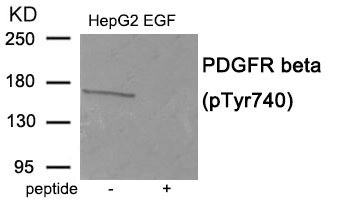
Western blot analysis of extracts from HepG2 cells treated with EGF using Phospho-PDGFR beta (Tyr740) antibody.The lane on the right is treated with the antigen-specific peptide.
Phospho-PDGFRB (Tyr740) Antibody

CSB-PA979025
ApplicationsWestern Blot, ELISA
Product group Antibodies
ReactivityHuman
TargetPDGFRB
Overview
- SupplierCusabio
- Product NamePhospho-PDGFRB (Tyr740) Antibody
- Delivery Days Customer20
- ApplicationsWestern Blot, ELISA
- CertificationResearch Use Only
- ClonalityPolyclonal
- ConjugateUnconjugated
- Gene ID5159
- Target namePDGFRB
- Target descriptionplatelet derived growth factor receptor beta
- Target synonymsActivated tyrosine kinase PDGFRB; beta-type platelet-derived growth factor receptor; CD140 antigen-like family member B; CD140B; IBGC4; IMF1; JTK12; KOGS; NDEL1-PDGFRB; PDGFR; PDGFR1; PDGFR-1; PDGF-R-beta; PDGFR-beta; PENTT; platelet-derived growth factor receptor 1; platelet-derived growth factor receptor beta; platelet-derived growth factor receptor, beta polypeptide
- HostRabbit
- IsotypeIgG
- Protein IDP09619
- Protein NamePlatelet-derived growth factor receptor beta
- Scientific DescriptionPDGF Receptor beta encodes a cell surface tyrosine kinase receptor for members of the platelet-derived growth factor family. These growth factors are mitogens for cells of mesenchymal origin. The identity of the growth factor bound to a receptor monomer determines whether the functional receptor is a homodimer or a heterodimer, composed of both platelet-derived growth factor receptor alpha and beta polypeptides. This gene is flanked on chromosome 5 by the genes for granulocyte-macrophage colony-stimulating factor and macrophage-colony stimulating factor receptor; all three genes may be implicated in the 5-q syndrome. A translocation between chromosomes 5 and 12, that fuses this gene to that of the translocation, ETV6, leukemia gene, results in chronic myeloproliferative disorder with eosinophilia. Mitchell D, et al. (2007) J Biol Chem 282, 15606-18Wu JH, et al. (2006) J Biol Chem 281, 37758-72 . Bae YS, et al. (2000)J Biol Chem 275, 10527-31.
- ReactivityHuman
- Storage Instruction-20°C or -80°C
- UNSPSC12352203
